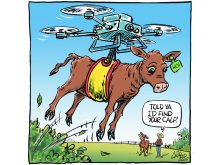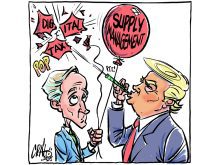Public opposition to gene editing appears to be fading into the sunset, and not a moment too soon.
There has been a lot of good news on this front lately.
The European Union announced earlier this winter that it is willing to treat gene edited crops differently than those developed using genetic modification. It was a small step, and a welcome one.
A new study from the United States found the technology is now seen more favourably in the court of public opinion. As well, Kevin Folta, a University of Florida plant scientist, recently told an agricultural conference in Winnipeg that the public is likely to accept gene edited crops and the underlying technology because it has beneficial applications for public health.
Read Also

Topsy-turvy precipitation this year challenges crop predictions
Rainfall can vary dramatically over a short distance. Precipitation maps can’t catch all the deviations, but they do provide a broad perspective.
“There are still some people out there screaming about it, but that opposition is getting weaker,” he said.
This is welcome news, but why did public acceptance for this technology come so much quicker than it did for genetic modification?
The answer lies in the early days of the GMO era in agriculture.
Those days began with rBST to increase milk production and suggestions of modifications to wheat, which of course is used in bread. Potential alterations to key staples raised immediate alarm among the public.
Roundup Ready canola was genetically modified so growers could kill weeds but leave the crop untouched. This came with several advantages for producers. In particular, it enhanced their ability to further reduce tillage while controlling weeds.
However, the product was designed for farmers, not consumers. It made it easier for farmers to farm and allowed Monsanto to sell a lot of Roundup, but didn’t directly affect the lives of consumers.
Resistance to genetic modification has never been as strong in North America as it is overseas, but opposition can still be noisy at times. The adoption curve for new ideas has always been long.
Pasteurization took decades to be fully accepted and still faces backlash in some quarters. Even the ubiquitous tractor only gained widespread acceptance 50 years after introduction.
But gene editing can produce results that have a positive impact on human lives.
In December, the U.S. Food and Drug Administration approved the technology to treat sickle cell disease.
Folta thinks using gene editing this way could be a game changer in public perception.
“In part because of its medical applications, I think you’ll see a very strong acceptance of these technologies.”
So that’s one lesson: focus more on the consumer than the producer.
Another lesson is the importance of using less scary language when describing new technology. One example is irradiation, in which food is exposed to enough radiation to kill insects, moulds and micro-organisms but not enough to remain in the food.
It took 25 years for this form of food processing to gain acceptance, likely because of unfortunate name choice.
Genetic modification led worried consumers to conjure up visions of “Frankenfood.”
Gene editing is more benign and is a valuable tool for improving crop production. Better drought resistance is now in reach, as is a solution to the increasingly dire threat of aphanomyces in lentil and pea production.
However, it’s important to recognize that the general public must also have skin in the game and be able to see benefits that extend beyond greater farm productivity or convenience.
The challenge is to make sure these new and vital crop breeding technologies are as relevant to consumers as they are to producers.
Karen Briere, Bruce Dyck, Barb Glen, Michael Robin, Robin Booker and Laura Rance collaborate in the writing of Western Producer editorials.















